Abstract
The growth of the hyperthermophilic, anaerobic bacterium Thermotoga neapolitana is stimulated by elemental sulfur by an unknown mechanism. We detected hydrogen-dependent sulfur reductase (sulfhydrogenase) and polysulfide dehydrogenase activities in cell extracts of this organism, demonstrating that it has at least two pathways for sulfidogenesis. Hydrogen-dependent sulfur reductase and hydrogenase activities are catalyzed by the purified hydrogenase of Thermotoga maritima, and this enzyme was called the sulfhydrogenase (K. Ma, R. N. Schicho, R. M. Kelly, and M. W. W. Adams, Proc. Natl. Acad. Sci. USA 90:5341-5344, 1993). Cells grown without elemental sulfur or cystine had 1.3 to 3.3 times higher sulfhydrogenase activities than those grown with either of these sources of sulfane sulfur. Hydrogenase activity was 2 to 5 times higher. Polysulfide dehydrogenase was up to 48-fold more active in cell extracts than the sulfhydrogenase. The activity of polysulfide dehydrogenase was approximately twofold higher when cells were grown in the presence of elemental sulfur. Its activity was oxygen labile in crude extracts, and it appears to be a cytoplasmic enzyme. Polysulfide was preferred over elemental sulfur as an electron acceptor (Km = 0.15 mM) and was more active with NADH (Km = 0.03 mM) than NADPH (Km = 0.41 mM). Growth in the presence of elemental sulfur appeared to slightly increase the activity of polysulfide dehydrogenase and slightly decrease both activities of sulfhydrogenase (hydrogenase and polysulfide reductase), while growth without elemental sulfur had the opposite effects. The greater activity of polysulfide dehydrogenase and its apparent regulation indicate that it is the more physiologically important means of polysulfide reduction.
Full text
PDF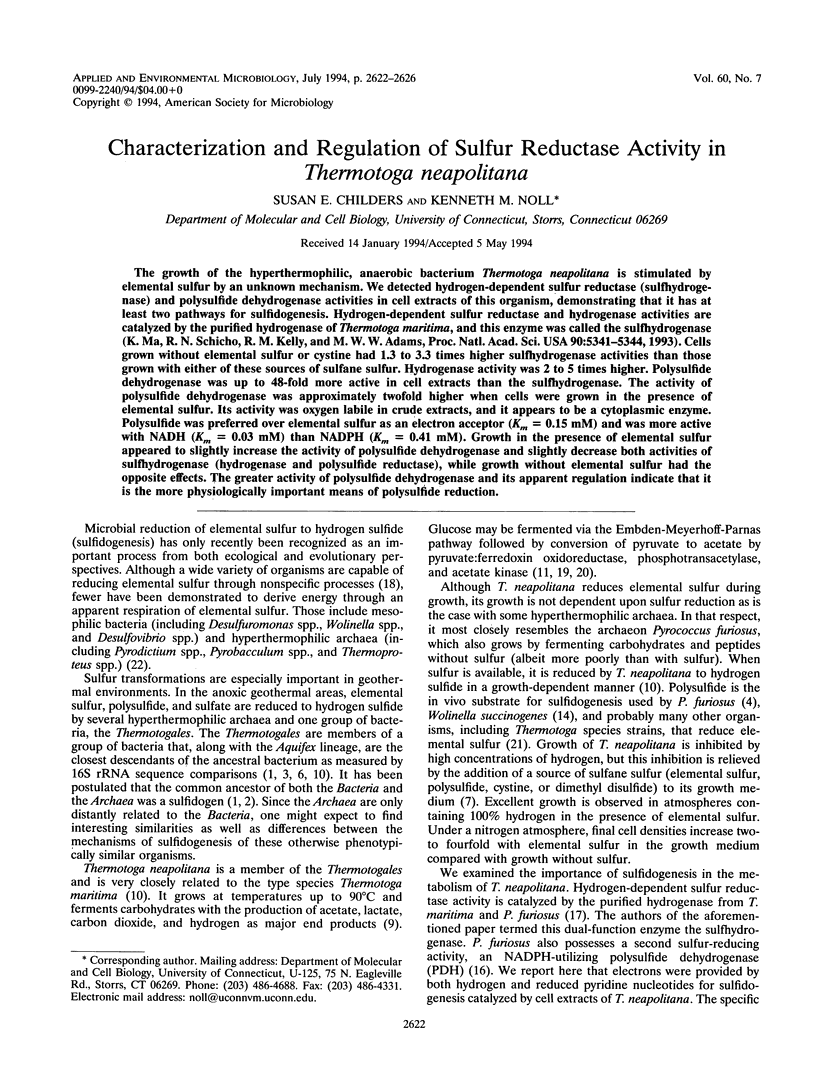
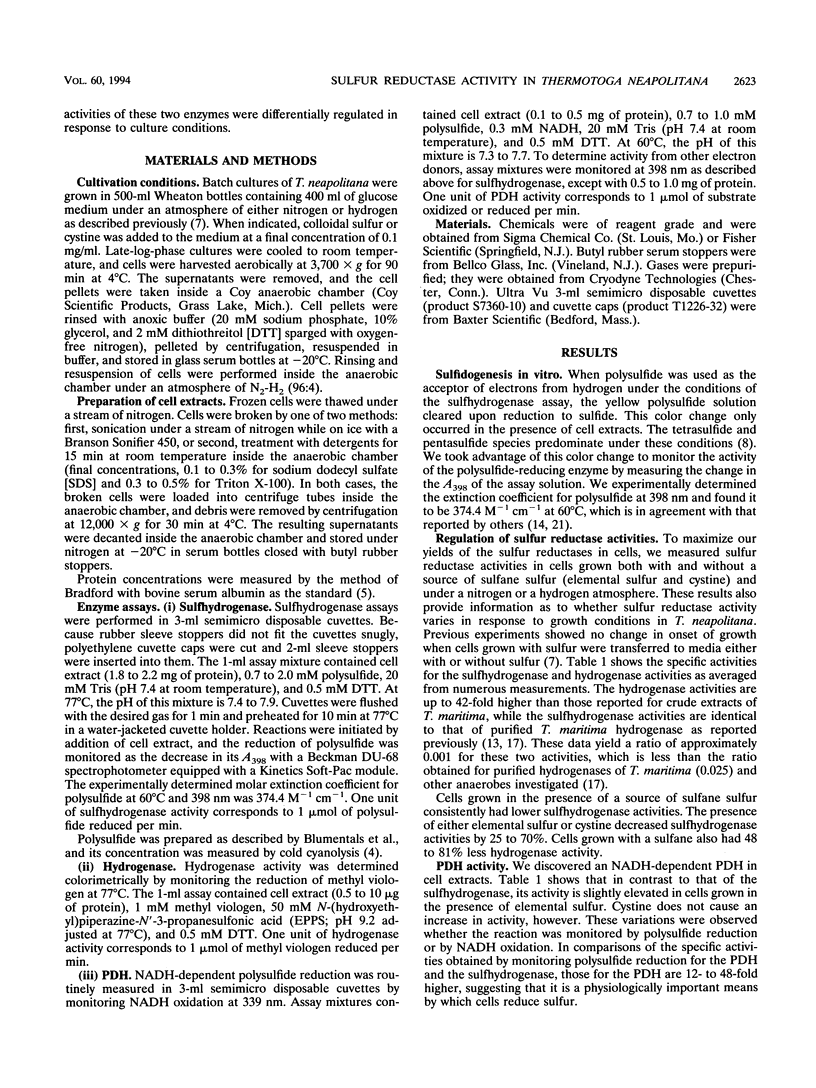
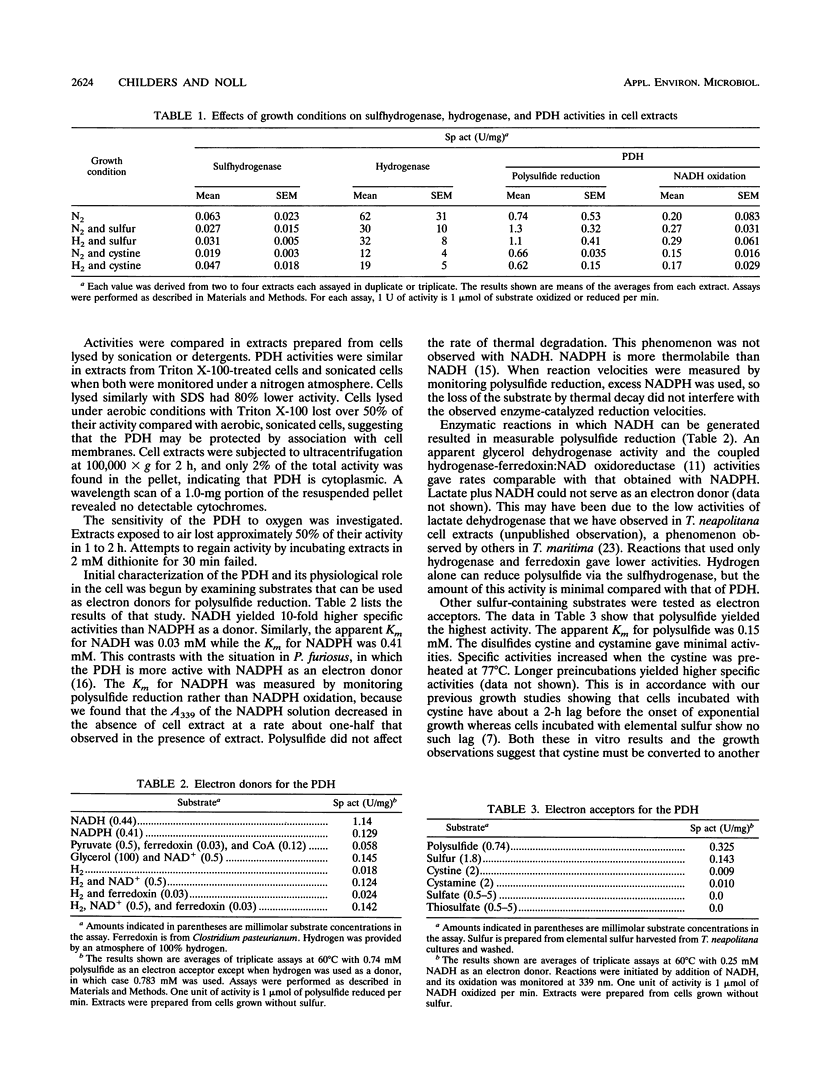
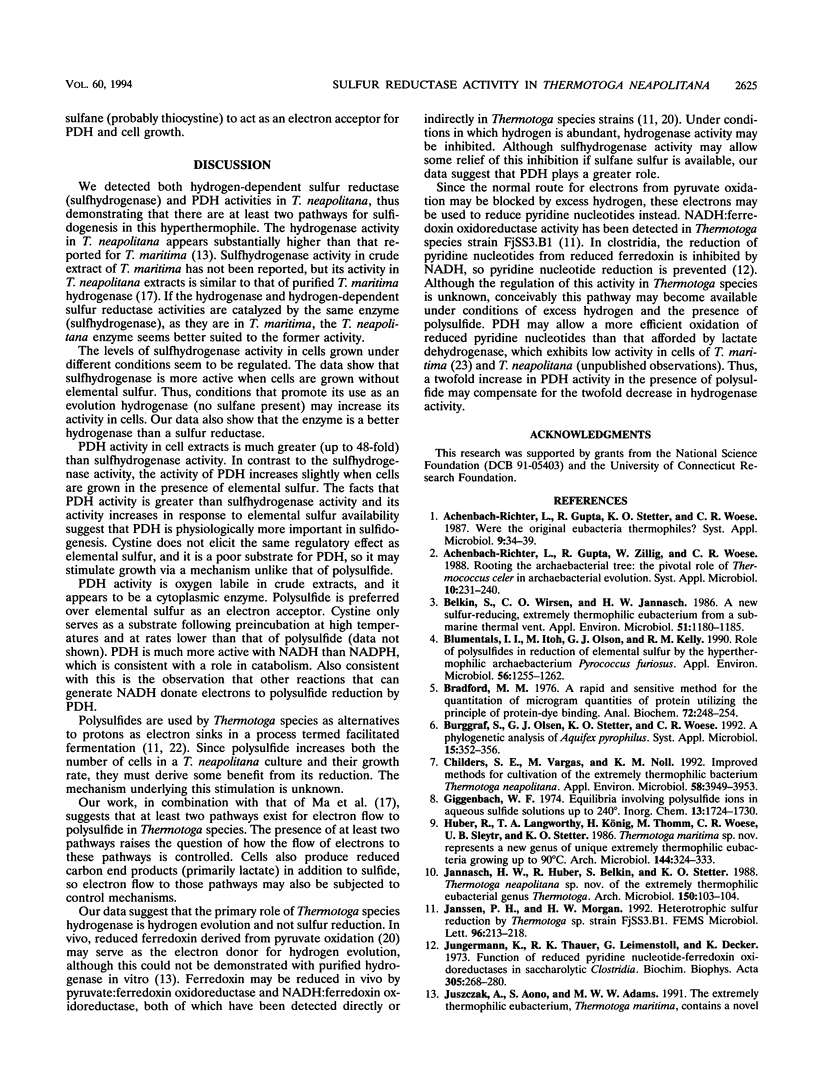
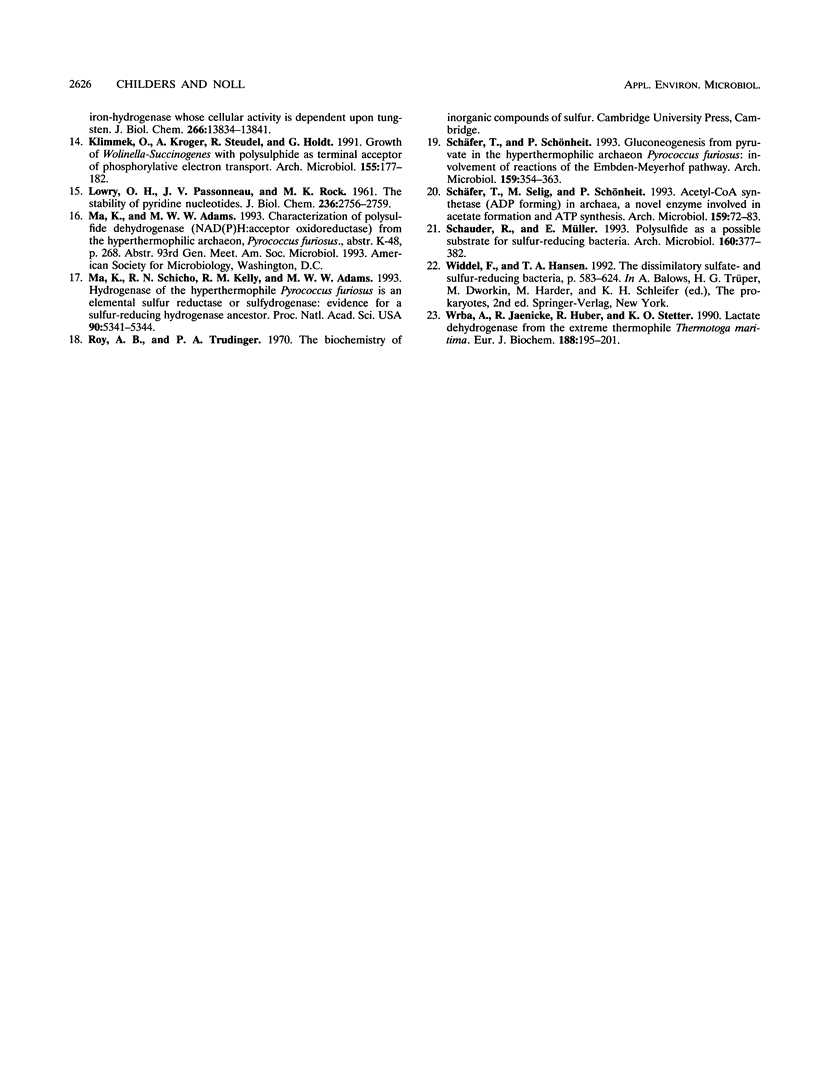
Selected References
These references are in PubMed. This may not be the complete list of references from this article.
- Achenbach-Richter L., Gupta R., Stetter K. O., Woese C. R. Were the original eubacteria thermophiles? Syst Appl Microbiol. 1987;9:34–39. doi: 10.1016/s0723-2020(87)80053-x. [DOI] [PubMed] [Google Scholar]
- Achenbach-Richter L., Gupta R., Zillig W., Woese C. R. Rooting the archaebacterial tree: the pivotal role of Thermococcus celer in archaebacterial evolution. Syst Appl Microbiol. 1988;10:231–240. doi: 10.1016/s0723-2020(88)80007-9. [DOI] [PubMed] [Google Scholar]
- Belkin S., Wirsen C. O., Jannasch H. W. A new sulfur-reducing, extremely thermophilic eubacterium from a submarine thermal vent. Appl Environ Microbiol. 1986 Jun;51(6):1180–1185. doi: 10.1128/aem.51.6.1180-1185.1986. [DOI] [PMC free article] [PubMed] [Google Scholar]
- Blumentals I. I., Itoh M., Olson G. J., Kelly R. M. Role of Polysulfides in Reduction of Elemental Sulfur by the Hyperthermophilic Archaebacterium Pyrococcus furiosus. Appl Environ Microbiol. 1990 May;56(5):1255–1262. doi: 10.1128/aem.56.5.1255-1262.1990. [DOI] [PMC free article] [PubMed] [Google Scholar]
- Bradford M. M. A rapid and sensitive method for the quantitation of microgram quantities of protein utilizing the principle of protein-dye binding. Anal Biochem. 1976 May 7;72:248–254. doi: 10.1016/0003-2697(76)90527-3. [DOI] [PubMed] [Google Scholar]
- Burggraf S., Olsen G. J., Stetter K. O., Woese C. R. A phylogenetic analysis of Aquifex pyrophilus. Syst Appl Microbiol. 1992 Aug;15(3):352–356. doi: 10.1016/S0723-2020(11)80207-9. [DOI] [PubMed] [Google Scholar]
- Childers S. E., Vargas M., Noll K. M. Improved Methods for Cultivation of the Extremely Thermophilic Bacterium Thermotoga neapolitana. Appl Environ Microbiol. 1992 Dec;58(12):3949–3953. doi: 10.1128/aem.58.12.3949-3953.1992. [DOI] [PMC free article] [PubMed] [Google Scholar]
- Janssen P. H., Morgan H. W. Heterotrophic sulfur reduction by Thermotoga sp. strain FjSS3.B1. FEMS Microbiol Lett. 1992 Sep 15;75(2-3):213–217. doi: 10.1016/0378-1097(92)90406-e. [DOI] [PubMed] [Google Scholar]
- Jungermann K., Thauer R. K., Leimenstoll G., Decker K. Function of reduced pyridine nucleotide-ferredoxin oxidoreductases in saccharolytic Clostridia. Biochim Biophys Acta. 1973 May 30;305(2):268–280. doi: 10.1016/0005-2728(73)90175-8. [DOI] [PubMed] [Google Scholar]
- LOWRY O. H., PASSONNEAU J. V., ROCK M. K. The stability of pyridine nucleotides. J Biol Chem. 1961 Oct;236:2756–2759. [PubMed] [Google Scholar]
- Ma K., Schicho R. N., Kelly R. M., Adams M. W. Hydrogenase of the hyperthermophile Pyrococcus furiosus is an elemental sulfur reductase or sulfhydrogenase: evidence for a sulfur-reducing hydrogenase ancestor. Proc Natl Acad Sci U S A. 1993 Jun 1;90(11):5341–5344. doi: 10.1073/pnas.90.11.5341. [DOI] [PMC free article] [PubMed] [Google Scholar]
- Wrba A., Jaenicke R., Huber R., Stetter K. O. Lactate dehydrogenase from the extreme thermophile Thermotoga maritima. Eur J Biochem. 1990 Feb 22;188(1):195–201. doi: 10.1111/j.1432-1033.1990.tb15388.x. [DOI] [PubMed] [Google Scholar]


